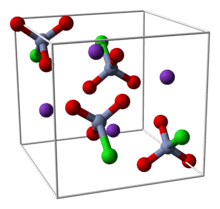Potassium chlorochromate
 | |
 | |
| Names | |
|---|---|
| Other names | |
| Identifiers | |
PubChem CID |
|
| Properties | |
| ClCrKO3 | |
| Molar mass | 174.54 g·mol−1 |
| Appearance | orange solid |
| Density | 2.5228 g/cm3 |
Except where otherwise noted, data are given for materials in their standard state (at 25 °C [77 °F], 100 kPa). | |
| Infobox references | |
Potassium chlorochromate is a inorganic compound with the formula KCrClO3.[4] It is the potassium salt of chlorochromate, [CrO3Cl]−. It is a water soluble orange compound is used occasionally for oxidation of organic compounds. It is sometimes called Péligot salt, in recognition of its discoverer Eugène-Melchior Péligot.
Structure and synthesis
Potassium chlorochromate was originally prepared by treating potassium dichromate with hydrochloric acid. An improved route involves the reaction of chromyl chloride and potassium chromate:[5]
- K2CrO4 + CrO2Cl2 → 2 KCrO3Cl
The salt consisting of the tetrahedral chlorochromate anion. The average Cr=O bond length is 159 pm, and the Cr-Cl distance is 219 pm.[6]
Reactions
Although air-stable, its aqueous solutions undergo hydrolysis. With concentrated hydrochloric acid, it converts to chromyl chloride. When treated with 18-crown-6, it forms the lipophilic salt [K(18-crown-6]CrO3Cl.[7]
Peligot's salt can oxidise the benzyl alcohol, a reaction which can be catalysed by acid.[8] A related salt, pyridinium chlorochromate, is more commonly used for this reaction.
Safety
Potassium chlorochromate can be toxic upon ingestion (may cause acute poisoning and kidney damage amongst other complications) or contact with the human skin (may cause eye burns, irritation, allergy, or ulceration), especially if inhalated.[9]
References
- ↑ Synonyms Of Chemicals. Csudh.edu (2003-09-16). Retrieved on 2011-06-01.
- ↑ Merck & Co (1930). Merck's index: an encyclopedia for the chemist, pharmacist and physician. Merck & Co. Retrieved 1 June 2011.
- ↑ Arthur Rose; Elizabeth Rose (1966). The Condensed chemical dictionary. Reinhold. Retrieved 1 June 2011.
- ↑ Norm Stanley Colorful Chromium Compounds, 23 August 2002
- ↑ Harry H. Sisler; Louis E. Marchi (1946). "Potassium Monochlorochromate". Inorg. Synth. 2: 208–210. doi:10.1002/9780470132333.ch64.
- ↑ U. Kolitsch (2002). "Redetermination of potassium chlorochromate, KCrO3Cl". Acta Crystallogr. E58 (11): i105–i107. doi:10.1107/S1600536802019396.
- ↑ Kotlyar, Sergei A.; Zubatyuk, Roman I.; Shishkin, Oleg V.; Chuprin, Gennady N.; Kiriyak, Andrey V.; Kamalov, Gerbert L. (2005). "(18-Crown-6)potassium chlorochromate". Acta Crystallographica E. 61 (2): m293–m295. doi:10.1107/S1600536805000085.
- ↑ Özgün, B.; Pek, A. (1991). "Kinetics and mechanism of the oxidation of benzyl alcohol by potassium chlorochromate". Reaction Kinetics & Catalysis Letters. 43 (2): 589–594. doi:10.1007/BF02064733.
- ↑ Susan Shaw; Susan D. Shaw; Monona Rossol (1 September 1991). Overexposure: health hazards in photography. Allworth Communications, Inc. pp. 122–. ISBN 978-0-9607118-6-4. Retrieved 1 June 2011.